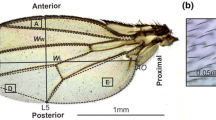Summary
In this paper we present an analysis of the behavior ofl(2)gl tsimaginal wing discs during culture in adult hosts. Thel(2)gl tslarvae reared at 29° C contain two types of wing discs, those that are morphologically normal and those that are abnormal. When discs of both types are cultured in adult hosts at 29° C, the restrictive temperature, they give rise to transplantable neoplastic tissue. However, when the 29° C reared discs are cultured at 15° C, the permissive temperature, the morphologically normal discs maintain their morphology, but the morphologically abnormal discs give rise to neoplasms. Thel(2)gl tslarvae reared at 15° C contain only morphologically normal discs. When these discs are cultured in adult hosts at 29° C they give rise to neoplasms, however if the discs are cultured at 15° C they maintain their normal morphology. These results demonstrate: (1) that all wing imaginal discs obtained from 29° C rearedl(2)gl tslarvae are competent to undergo neoplastic development, (2) the morphologically abnormal discs obtained from the 29° C rearedl(2)gl tslarvae are committed to neoplastic development, (3) the neoplastic development of the morphologically normal discs is temperature dependent, (4) once the neoplastic development of thel(2)gl tsdiscs has been initiated the process is not readily reversible. In addition, the ability ofl(2)gl tswing discs to perform epimorphic regulation was tested by amputating morphologically normal permissively rearedl(2)gl tswing discs and culturing both fragiments at the permissive temperature. Fragments of control wild-type discs maintained their morphology during culture at the permissive temperature. However, both fragments of txel(2)gl tsdiscs became neoplastic. This result is discussed with respect to a possible role for thel(2)gl +function in epimorphic regulation and with respect to the phenomena of tumor promotion in vertebrates.
Similar content being viewed by others
References
Arking R (1975) Temperature-sensitive cell-lethal mutants ofDrosophila: isolation and characterization. Genetics 80:519–537
Berenblum I (1954) A speculative review: the probable nature of promoting action and its significance in the understanding of the mechanism of carcinogenesis. Cancer Res 14:471–477
Bryant PJ (1975) Pattern formation in the imaginal wing disc ofDrosophila melanogaster: fate map, regeneration, and duplication. J Exp Zool 193:49–78
Clark WC, Russel MA (1977) The correlation of lysosomal activity and adult phenotype in a cell-lethal mutant ofDrosophila. Dev Biol 57:160–173
Dale L, Bownes M (1980) Is regeneration inDrosophila the result of epimorphic regulation. Wilhelm Roux's Arch 189:91–96
Friedewalde WF, Rous P (1950) The pathogenesis of deferred cancer. A study of the aftereffects of methylcholanthrene of rabbit skin. J Exp Med 91:459–484
Gateff E (1978a) Malignant neoplasms of genetic origin inDrosophila. Science 200:1448–1459
Gateff E (1978b) Malignant and benign neoplasms ofDrosophila melanogaster. In: Ashburner M, Wright TRF (eds.) The genetics and biology ofDrosophila, vol 2b. Academic Press, New York, pp 181–275
Gateff E, Schneiderman HA (1967) Development studies of a new mutation ofDrosophila melanogaster: lethal malignant brain tumor,l(2)gl 4.Am Zool 7:760
Gateff E, Schneiderman HA (1969) Neoplasms in mutant and cultured wild-type tissues ofDrosophila. Wilhelm Roux' Arch 176:23–65
Girton JR, Russel MA (1980) A clonal analysis of pattern duplication in a temperature-sensitive cell-lethal mutation ofDrosophila melanogaster. Dec Biol 77:1–21
Hanratty WP (1980) Isolation and characterization oftemperature-sensitive lethal (2) giant larva alleles. I. Mutagenesis and larval pathology. Wilhelm Roux's Arch 193:90–97
Lindsley DL, Grell EH (1968) Genetic variations ofDrosophila melanogaster. Carnegie Inst Publ No 627. Wshington DC
Schubiger G (1971) Regeneration, duplication, and transdetermination in fragments of the leg disc ofDrosophila melanogaster. Dev Biol 26:277–295
Sonnenblick BP (1950) The early embryology ofDrosophila melanogaster. In: Demerec M (ed). Biology ofDrosophila. Hafmer, New York, pp 62–167
Suzuki DT (1970) Temperature-sensitive mutations inDrosophila melanogaster. Science 170:695–706
Ursprung H (1967)In vivo culture ofDrosophila imaginal discs. In: Wilt GH, Wessels MK (eds). Methods in developmental biology, Crowell, New York, pp 485–492
Waddington CH (1935) Cancer and the theory of organizers. Nature 135:606–608
Williams JM (1981) Tumorigenesis inDrosophila melanogaster bearing the temperature-sensitive mutationshibere ts1.Dros Info Serv 56:158–161
Wright TRF, Steward R, Bentley KW, Adler PN (1981) The genetics of dopa decarboxylase deficient mutation on female sterility. Dev Genet 2:223–235
Author information
Authors and Affiliations
Rights and permissions
About this article
Cite this article
Hanratty, W.P. Isolation and characterization of temperature-sensitivelethal(2)giant larva alleles. Wilhelm Roux' Archiv 193, 98–107 (1984). https://doi.org/10.1007/BF00848637
Received:
Accepted:
Issue Date:
DOI: https://doi.org/10.1007/BF00848637




